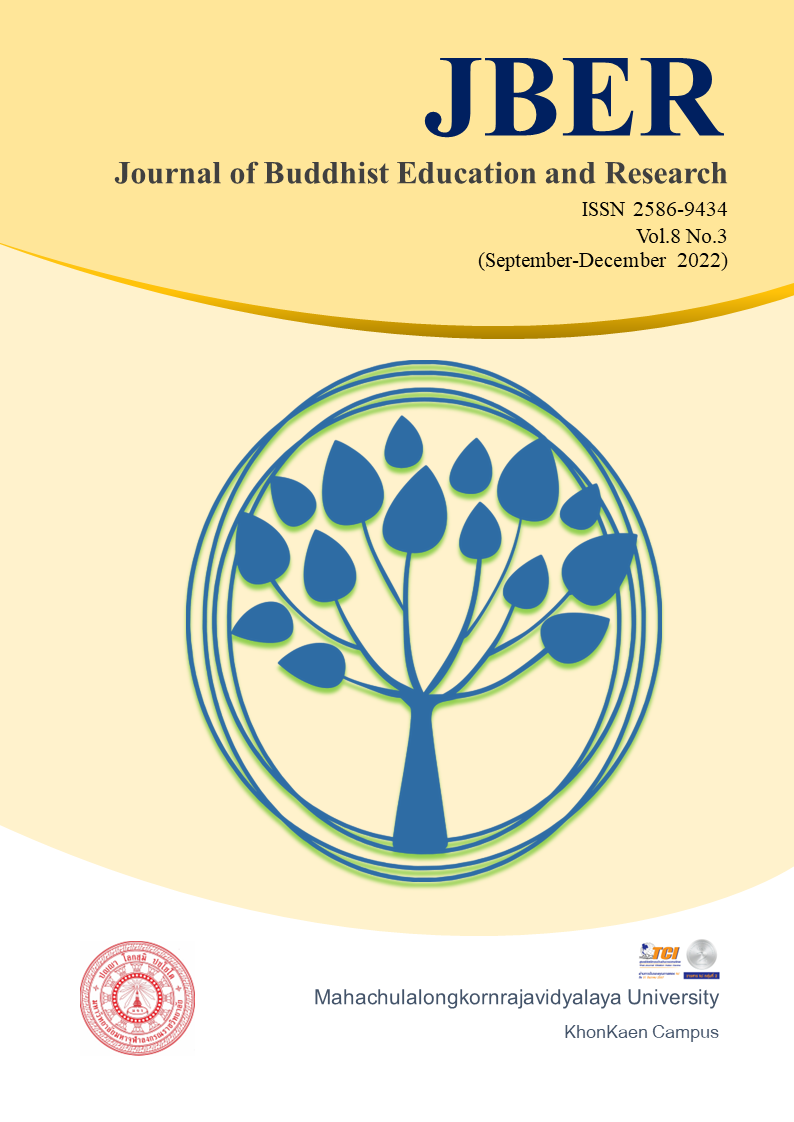EFFECTIVE ACTIVE LEARNING MANAGEMENT OF ECONOMICS FOR VISUALLY IMPAIRED STUDENTS IN CHIANGMAI
Keywords:
visually impaired students, Active learning, EconomicsAbstract
This research is qualitative research. The purpose of this research was to study effective active learning management of economics for visually impaired students in Chiangmai. Key informants (9 involving experts) compose of 1) social studies teachers in the regular secondary schools in Chiangmai 2) special education teachers who teach social studies and 3) visual impaired students who attend the secondary schools. To achieve the research objective, we divided the scope of the research into 6 areas namely 1) teachers, 2) students with visual impairments, 3) content, 4) learning materials, 5) learning activities, and 6) the atmosphere of learning management. Data were collected by non-participant observations and semi-structured interviews and validated by triangular methods. Thematic and synthetic analysis were then applied and interpreted for a guideline of an effective active learning management of economics for visually impaired students in Chiangmai.
The results revealed that regular secondary schools and schools for the blind had appropriate learning management conditions in various fields but lacked learning materials for students with the visual impairment. Economics was, from teachers’ experience, a difficult subject for learners to understand. However, to a certain extent, the school managed the learning activities effectively. But what can be done more is simply the use of active learning and the child center approach that open more opportunities for students to participate and access the content closer to their life. Teachers should stimulate students by using learning tools appropriately and at the same time create a better learning environment for their special students.
References
กระทรวงการพัฒนาสังคมและความมั่นคงของมนุษย์. (2563). รายงานข้อมูลสถานการณ์คนพิการในประเทศไทย. สืบค้นเมื่อ 1 กันยายน 2564, จาก http://dep.go.th/.
ชลลดา สะอาดวงค์. (2557). ผลการใช้มาตรฐานการเรียนร่วม ในโรงเรียนแกนนำจัดการเรียนร่วม สังกัดสำนักงานเขตพื้นที่การศึกษาประถมศึกษาลำพูน เขต 2. วิทยานิพนธ์ศึกษาศาสตรมหาบัณฑิต มหาวิทยาลัยเนชั่น.
จิรายุทธิ์ อ่อนศรี. (2562). บทบาทครูในการสร้างบรรยากาศการเรียนรู้. สืบค้นเมื่อ 1 กันยายน 2564, จาก shorturl.asia/RcOa3.
จีรวรรณ ศรีวงษ์, ปราณี อัศวภูษิตกุล, อนุรักษ์ อยู่วัง. (2564). รูปแบบเครือข่ายความร่วมมือ: กรณีศึกษาห้องสมุดและสถาบันบริการสารสนเทศเพื่อผู้บกพร่องทางการเห็น. วารสารบรรณศาสตร์ มศว, 14(1).
พระราชบัญญัติการศึกษาแห่งชาติ พุทธศักราช 2542. (2542, 14 สิงหาคม). ราชกิจจานุเบกษา.
พระวีรศักดิ์ จนฺทวํโส, พระครูวิริยปัญญาภิวัฒน์, พระเอกรัตน์ มหามงฺคโล (มาพะดุง) และพระมหาสมบัติ ฐานวโร. (2561). การจัดการเรียนรู้แบบบูรณาการวิชาสังคมศึกษา. รายงานการประชุมวิชาการระดับชาติ ครั้งที่ 2.
รัตติยากร สำราญพิศ และจุมพล ราชวิจิตร. (2559). สภาพปัญหาและความต้องการเกี่ยวกับการผลิตและใช้สื่อการเรียนรู้ในโรงเรียนการศึกษาคนตาบอด จังหวัดขอนแก่น. วารสารศึกษาศาสตร์ ฉบับวิจัยบัณฑิตศึกษา, 1(2).
โรงเรียนสอนคนตาบอดกรุงเทพ. (2561). หลักสูตรการฝึกทักษะ O&M. สืบค้นเมื่อ 1 กันยายน 2564, จาก https://www.blind.or.th/centre/intoProduct/1/?id=82.
วารี ถิระจิตร. (2545). การศึกษาสำหรับเด็กพิเศษ. (พิมพ์ครั้งที่ 3). กรุงเทพฯ: สำนักพิมพ์แห่งจุฬาลงกรณ์.มหาวิทยาลัย.
สถาพร พฤฑฒิกุล. (2558). การจัดการเรียนการสอนแบบ Active Learning. โครงการจัดการความรู้ (Knowledge Management) คณะเทคโนโลยีการเกษตร มหาวิทยาลัยบูรพา วิทยาเขตสระแก้ว. สืบค้นเมื่อ 1 กันยายน 2564, จาก https://km.buu.ac.th/article/frontend/article_detail/14
สุนิสา สกุลเกื้อกุล, หยกแก้ว กมลวรเดช และสุกัญญา รุจิเมธาภาส. (2563). รูปแบบการจัดการศึกษาแบบเรียนร่วมสำหรับสถานศึกษาในจังหวัดน่าน. วารสารมหาจุฬานาครทรรศน์, 7(8), 363-380.
สำนักงานคณะกรรมการการศึกษาขั้นพื้นฐาน. (2553). คู่มือประเมินสมรรถนะครู (ฉบับปรับปรุง). สืบค้นเมื่อ 1 กันยายน 2564, จาก http://www.tw-tutor.com/downloads/competency.pdf.
อภิชาติ ทองน้อย. (2549). การจัดการศึกษาสำหรับคนพิการทางการมองเห็นในเขตกรุงเทพมหานคร และปริมณฑล. วิทยานิพนธ์ศึกษาศาสตรมหาบัณฑิต มหาวิทยาลัยธุรกิจบัณฑิตย์.
อรรณพ จีนะวัฒน. (2559). การพัฒนาตนของผู้ประกอบวิชาชีพครู. วารสารอิเล็กทรอนิกส์ Veridian มหาวิทยาลัยศิลปากร (มนุษยศาสตร์สังคมศาสตร์และศิลปะ). 9(2).
Bonwell, C. C., &Eison, J. A.. (1991). Active learning: Creating excitement in the classroom. Washington, DC: Education Resource Information Center (ERIC).
Carney, S., Engbretson, C., Scammell, K. and Sheppard, V.. (2003). teaching students with visual impairments a guide for the support team. Saskatchewan Learning.
Ghosh, I. (2018). The importance of studying economics in today’s world. Retrieved September1 ,2021, from https://www.financialexpress.com/education-2/the-importance-of-studying-economics-in-todays-world/1192135/.
Kapur, R. (2018). Challenges Experienced by Visually Impaired Students in Education. Retrieved September1, 2021, from https://www.researchgate.net/publication/323833804_Challenges_Experienced_by_
Visually_Impaired_Students_in_Education
Khadjooi, K., Rostami, K., Ishaq, S. (2011). How to use Gagne's model of instructional design in teaching psychomotor skills. Gastroenterol Hepatol Bed Bench, 4(3), 116–119.
Kızılaslan, A. (2020). Teaching Students With Visual Impairment. Nova Science Publisher, ISBN: 978-1-53617-166-2.
Otyola, W. R., Kibanja, G. M. and Mugagga, A. M. (2017). Challenges Faced by Visually Impaired Students at Makerere and Kyambogo Universities. Makerere Journal of Higher Education, 9(1).
United Nations Development Programme. (2019). Sustainable Development Goals. Retrieved September1, 2021, from https://www.undp.org/content/undp/en/home/sustainable
/sustainable-developmentgoals.html
Willings, C. (n.d.). Social Studies Adaptations. Retrieved September1, 2021, from https://www.teachingvisuallyimpaired.com/social-studies-adaptations.html.





